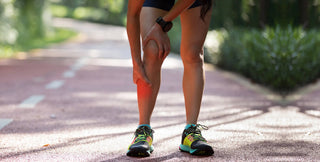Table of Contents
1. Shin Splints
Pain across the front of the leg and proximal tibia is referred to as Medial Tibial Stress Syndrome (MTSS), also known as shin splints. The pain will be felt at the front of your leg, above your knee and ankle. Shin splints are a condition caused by overexertion that affects many people. They can be caused by long jogging runs, high-intensity sports, and a lack of sufficient stretching.
2. How to Get Rid of Shin Splints?
Are you looking forward to getting rid of shin splints? Read to learn how.
Your shin muscles in the front and back of your lower leg are important for walking and running. Spending a little effort to improve the condition of your shins may make other workouts and running more comforting and enjoyable.
3. Exercises for Shin Splints
Exercising regularly is beneficial in itself. It may seem exhausting now but your body will thank you later.
Whether you are a beginner or an athlete, before setting out on your run, make sure you warm up for a few minutes and start at a slow pace before increasing your speed and distance traveled. Starting gradually is the key.
Very often, the reason why shin splints occur is because runners start without warming up or run for long distances. Shin splints can go away with rest but the pain may last for a few days.
According to Sascha Wingenfeld, a running expert and coach,
"These pains are a symptom of medial tibial stress syndrome (MTSS), sometimes known as shin splints. It is estimated that this overloaded phenomenon is responsible for about one-quarter of all training pauses. Pain normally builds up over several weeks, and in severe situations, it can make running practically difficult."
The following stretching and strengthening exercises can prevent and ease pain caused by shin splints.
3.1. 7 Best Shin Strengthening Exercises
The following shin strengthening exercises will help make your shin bone and muscles more resistant.
- Standing calf raise
- Ankle circle
- Strengthening the foot and lower leg
- Hip raise with heel pull
- One leg floor calf raise
- Strengthening the gastroc soleus muscles
- Strengthening the anterior tibialis
3.1.1. Standing Calf Raise

- Press onto the sole of your foot.
- Elevate your heel until you're standing on your toes.
- Then slowly lower yourself back to the starting position.
- Repeat for three to five minutes.
3.1.2. Ankle Circle

- Begin by softly twisting your ankle to the left and then to the right in circles.
- You might find it simpler to draw the letters with your foot in the air.
- Keep your motions modest and limited to your foot and ankle, rather than using your entire leg.
- Try performing 10 circles with each foot in both directions.
3.1.3. Strengthening the Foot and Lower Leg
- Sit up straight in a chair with your feet flat on the floor.
- Raise your heels while keeping your feet flat on the floor.
- Return to the floor by lowering your heels.
- Press down into your knees and raise your legs up against your hands.
- Repeat for three to five minutes.
3.1.4. Hip Raise with Heel Pull
- Sit up straight and spread your feet hip-width apart in a fetal position with your knees extended and your feet flat on the floor.
- Keep your abs pushed in and your back flat on the floor.
- Place your hands at your sides and flat on the ground.
- Raise your heels off the floor and support yourself on your toes.
- Slowly spread your legs by turning your knees out to the sides.
- Return to the beginning posture by closing your legs with control; this is considered a single rep.
- Within 30 seconds to one minute, do as many repetitions as you can while maintaining good posture.
3.1.5. One Leg Floor Calf Raise

- Place the block against a wall or near a machine.
- On your left foot, stand upon that block with the heel of the foot resting on the block's edge.
- Your right ankle should be wrapped over your left ankle.
- Allow the heel to slide as far as it can go.
- Slowly elevate the heel as high as you can.
- After a little pause, carefully lower the heel.
- Repeat this movement for the required number of reps.
3.1.6. Strengthening the Gastroc Soleus Muscles

- Stand with your feet spread apart at shoulder-width
- Bend one leg over a bench or chair
- On the count of three, raise your heels then lower them on the count of five.
- You must be on the tips of your toes
- Stand against the wall for support
- Do 15 to 20 reps daily.
3.1.7. Strengthening the Anterior Tibialis

- Sit on a chair.
- Pullan exercise band over the top of your foot and tie it around something solid.
- As you bend your ankle toward you, keep your foot pointed up
- Do 15 to 20 reps daily.
4. Takeaways
By stretching and strengthening your shin muscles, you lessen the chances of getting shin splints. So it is better to stretch and strengthen your muscles regularly.
The exercises mentioned above are simple and can be done at home easily.
"This article is originally posted on borntough.com, and borntough.com own the sole copyright on this article. If you read this article outside borntough.com, please report this website to the authority because they have stolen the content from borntough.com and violated borntough copyright"
